Friday, October 26, 2001
Saturday, October 27, 2001
[Note: This page is a quickly copied version of our original post, some formatting may be disrupted in the process]Naval Postgraduate School
Monterey, California
Local Host:Bruce Denardo
(831) 656-2952
denardo@physics.nps.navy.mil
| Very Important AnnouncementUPDATED 10/24Due to the national state of emergency, the Naval Postgraduate School is currently allowing entrance only to employees or to people whose names are on a list at the guard gate. Each person must present a photo ID, which is checked with the person’s face. The guards are armed, and vehicles are randomly searched (this only requires a few minutes).As you show the guard your photo ID, tell him or her that you are here for “the physics teachers conference.”
We plan to have the name of every current and recent past member of the Northern California/Nevada section of AAPT on the list. If you plan to attend the meeting and are not or have not recently been a member of our section, please email your name and the name of your institution to Bruce Denardo (denardo@physics.nps.navy.mil) by 8:00 am on Thursday, Sept. 25. After that time we can’t guarantee your name will be forwarded to the security post.
Consult the map for parking areas. This is not a problem during the weekends or mid-to-late Friday afternoons. (This is the good news.)
Due to the continually changing state of conflict, NPS may be at a higher threat condition at the time of the meeting. In this case, we plan to hold the meeting at the Monterey Conference Center in downtown Monterey. The demonstration workshop and laboratory tours will have to be canceled. All other activities will occur as scheduled. Please check this web site for the latest information.
|
Note on ParkingFriday WorkshopsTeachers are welcome to contact our President,
Dave Wall, for a letter of support to assist them in obtaining funds and release time to attend this conference.
“New Teacher Workshop” (10 am – 3 pm) Spanagel 101A
by: Paul Robinson, Lonnie Grimes, Dean Baird
This popular workshop is a day-long version being offered on Friday (instead of Saturday afternoon) so that participants don’t have to miss out on the contributed papers. It is intended for teachers who are either new to teaching physics and/or those who have been at it for a while but still feel like they’re new! All new teachers will be networked with experienced teachers. The workshop includes valuable teaching tips, goodie bags, raffles where everyone wins, question and answer panels, popcorn, and more! Interested participants should email Paul Robinson at laserpablo@aol.com to register or for more information. If you wish to attend a NTW but can’t make it Friday, email Paul Robinson anyway&endash;&endash;if there are insufficient signups for Friday an abbreviated 2-hour version on Saturday afternoon may be offered instead. No fee.
“Dramatic Physics Lecture Demonstrations” (2:30 – 4:30 pm) Spanagel 117 and 135
by: Bruce Denardo, Scott Davis, Daphne Kapolka,
Gamani Karunasiri, Kevin Smith, and Don Walters
Dramatic and unusual demonstrations will be performed, explained, and discussed. A handout is planned to be distributed. The demonstrations will tentatively include the following. Mechanics: circular/harmonic motion, Coriolis force, Foucault model, giant spool-and-rope, parametric instability, parallel axis theorem. Fluid mechanics: giant vortex bottle, toroidal bubbles, giant hydrostatic balance. Acoustics: acoustic levitation, multipole radiation source, jetting from resonator, shock tube, slappers and clappers, acoustic radiometer, spinning cup, baffled loudspeaker, phase locking. Thermodynamics: liquid nitrogen-water canon. Electricity and magnetism: electromagnetic can crusher, electrostatic screening, terminal velocity due to magnetic damping, giant Tesla coil, electromagnetically coupled oscillators. Optics: infrared camera, balloon microphone, acousto-optic transduction and lightwave transmission, night vision scope. Modern physics:model of fermion antisymmetry for 360o rotation.
Please sign up for the workshop by emailing Bruce Denardo at denardo@physics.nps.navy.mil. There is no fee.
Friday Laboratory Tours5:10&endash;5:30 pm, Lab Tour, Spanagel 017
“Acoustophoresis and Time-Reversal Acoustics”
Ed Tucholski, Naval Postgraduate School
The Advanced Acoustics Research Laboratory is home to these two research areas. One is on acoustophoresis which is the separation of objects using high intensity sound. Experiments in progress are studying the effect of loud sounds on gas bubbles in water and aerogels in both air and water. An oil-water separation column using bubbles, which are segregated in size using sound, is under construction. The second research area, time&endash;reversal acoustics, takes place in a long water tank, where the technique is used for communications and active submarine detection.
Friday Evening Social6:30 PM La Novia Room, Herrmann Hall
Libations, munchies, and other delicious treats!
7:10 PM “Quantum Mechanics of Nanotechnology”
James Luscombe, Naval Postgraduate School
Following the historic trend in miniaturizing electronic components, minimum device sizes will reach 100 nanometers in the near future. This size is significant for two reasons. First, as will be explained, in the sub-100 nanometer regime the physical principles upon which conventional electron devices are based will no longer be suitable for device operation. At the same time, quantum effects will come to predominate as device sizes become comparable with electron wavelengths in semiconductors. I will describe progress in developing nanometer-scale quantum-effect electron devices and explain how they can be understood using standard undergraduate quantum physics.
Saturday ScheduleSaturday, Oct 27 (in Mechanical Engineering Auditorium, except for lab tours)7:45 Registration, Coffee, Donuts, and other culinary delights
8:45 Welcome and Announcements
9:00 Show & Tell
Share your favorite demonstration or teaching tip. Since new teachers and section members will be at this meeting, you are encouraged to dust off some of your oldies but goodies. If you have handouts, please bring 100 copies. Time limit is 5 minutes per person.
10:00 Invited Talk
“Time-Reversal Acoustics”
Andrés Larraza, Department of Physics, Naval Postgraduate School
Until recently, focusing of acoustic pulses through media with complex propagation properties had been a very difficult problem. As analog-to-digital converters have become faster, a novel technique called time-reversal acoustics has been able to overcome this difficulty. In a common realization, the time-reversal acoustic technique consists of transmitting an acoustic signal from a point-like source, digitizing the analog signal received by a microphone or a hydrophone, time reversing the signal, and retransmitting it from a nearby source. Applications of time-reversal acoustics are numerous and include medical applications (imaging and lithotripsy), nondestructive testing, underwater acoustic communications and sonar, and counter-mine warfare.
11:00 Invited Talk
“Free Electron Lasers of Today”
W. B. Colson, Naval Postgraduate School
Imagine a laser that is continuously tunable over a wide range of frequencies and that can be designed to operate where conventional lasers do not exist. This new kind of laser has already operated at microwave, far infrared, visible, ultraviolet, and even down to X-ray wavelengths. In addition, it can run reliably and efficiently for hours, days, or even weeks with only minor maintenance, producing CW laser light or short sub-picosecond pulses. This is the FREE ELECTRON LASER which contains only the essential ingredients for light amplification by stimulated emission: an external field, the laser light, and free electrons. FELs use a beam of relativistic electrons passing through a periodic, transverse magnetic field to amplify the co-propagating laser light.
12:00-1:00 pm Lunch (on-your-own)
1:00-2:00 Lab Tours
Rail guns lab tour (Adamy and Snyder, Spanagel 011)Acoustic detection of buried mines (Muir, Spanagel 025)
Thermoacoustic heat engines (Hofler, Spanagel 036)
2:00 Raffle/Business Meeting
Contributed PapersMechanical EngineeringAuditorium
2:20 “Fusion Technology at Low Temperatures”, Charles Jordan, Foothill College, egonjoe@home.com
There are now refereed papers from SRI and LANL confirming nuclear reactions at low temperatures and I have new results in cavitation driven nuclear fusion processes producing helium in large quantities and 75 watts of extra energy in a light bulb size reactor. I will review the present state of affairs in the investment community and the present understanding of the mechanism.
2:40 “Teaching Physics with Micro Electro Mechanical Systems (MEMS)”, Cindy Krysac, Department of Physics, University of the Pacific, krysac@artemis.cop.uop.edu
A small but developing collection of classroom examples and problems using MEMS will be presented as illustrations of the application of thermal, electrical, mechanical, optical and acoustical physics to an advanced, modern technology. Use of these classroom examples engages students in learning about the emerging technology, emphasizing the importance of a fundamental physics education to the development of such technology.
3:00 “Where Does the Plutonium Come From?”
Paul Peter Urone, California State University, ppu@csus.edu
238Pu is used as an energy source in deep space probes. While the technique for the manufacture of 239Pu is commonly known, that for 238Pu is not. There are a number of interesting classroom and homework problems as well as student projects related to 238Pu. Among these are the production techniques themselves, the characteristics and uses of 238Pu, and its biological hazards. I will discuss a few of these in some detail and make suggestions for others.
3:20 “The String Machine”, Cheuk K. Chau California State University, Chico, CKCHAU@csuchico.edu
During the Spring 2001 NCNAAPT meeting at Berkeley, Don Rathjen of Exploratorium Teacher Institute demonstrated his amazing string machine. With a motor at each end of a string he generated a one-loop standing like pattern. By pinching the string at certain locations, a two-loop, three-loop and four-loop pattern appeared. Did the string change from one resonance frequency to another instantaneously? In this talk we will demonstrate and present an analysis on the string machine.
3:40 “Putting: The Prequel”, Scott K. Perry, American River College, skparc@home.com
Before golfers can even begin to worry about the Holmesian capture cross-section of the cup in the middle of a putting green, they must first get the ball to the hole. “Reading the break” on a sloping green can be very tricky making the selection of the proper velocity vector difficult. A computer putting simulation will be discussed along with the results of experiments conducted on local practice greens. A discussion of the apparent paradoxical nature of rolling friction will also be presented.
4:00 “Colliding Magnetic Pendula: When is a collision not collision-like?”, David Kagan and Chris Gaffney, California State University, Chico, dkagan@csuchico.edu, cgaffney@csuchico.edu
This talk will review the subtle physics of the Newtonian Demonstrator (five colliding balls suspended from strings) and illustrate the key issues by introducing the MagnaSwing which is a Newtonian Demonstrator made with repeling magnets instead of steel balls.
4:20 “QuarkNet”, Fred Oswald (retired) Napa, NSOH@aol.com
Next summer QuarkNet will be offering a three-week shortened course for twelve new teachers at each site.Generous stipends and $250 equipment funds for the next two years are provided for selected participants. AAPT members are excellent candidates for the program. This “paper” is designed to make physics teachers aware of the program, hopefully recruit new participants for next summer’s classes, and provide an opportunity for last summer’s participating teachers to describe the affect the training has had on their classes.
4:40 “The Anatomy of a Homer”, Paul Robinson, San Mateo High School, laserpablo@aol
Many high schools do a “Bull’s Eye” lab activity in which students predict the horizontal range of a projectile launched from a ramp. I have developed a follow-up activity in which home runs are analyzed as a bull’s eye with a mirror image. Since our study of projectiles is about the same time as the playoffs and World Series, it is easy to capitalize on student interest in baseball. It is an excellent way to discuss trajectories, estimated distances of home runs, air friction, components, maximum heights, etc. in a fun and engaging manner. An analysis of Barry Bonds 73rd homer will be presented as an example.
Dues and Don’tsSection dues are $10 per year, due each Fall. If you cannot attend the meeting, remain an active member which will ensure you’ll receive all our mailings by sending dues to our treasurer Dennis Buckley, Liberty High School, 850 Second St., Brentwood, CA 94513. The registration fee for the Fall meeting is $10, payable at the door.
First-timers are free!
MOTEL INFORMATION
Regarding the Fall 2001 meeting of NCNAAPT at the Naval Postgraduate School in Monterey, CA, which is on Friday and Saturday, October 26-27:The following is a message from “A Place to Stay,” which is a free room finder service that may help you locate a room in the Monterey area.
Due to the popularity of the Monterey Peninsula as a vacation, conference, and wedding destination, it is highly advised that you consider now making your plans to attend the upcoming meeting of the NCNAAPT at the Naval Postgraduate School (NPS). As a general rule, there is a two night minimum stay when a weekend night is involved. We suggest you call and reserve a room early in order to guarantee a place to stay. Most places have a 3-day cancellation policy prior to the arrival date. Keep in mind the variance in rates depend on number of beds in a room, number of people in the room, and whether or not it is a weekday or weekend night. Again, we strongly suggest you book your room early. You may also call A Place To Stay at (800) 364-1867. Our web site is www.carmel-aplacetostay.com.
The following is a list of some names, phone numbers, and a range of rates for motels that are near NPS. More motels are listed on our web site. Some motels have conference rates, particularly those within walking distance of NPS (marked with an asterisk).
*Monterey Fireside Lodge, $89.00 to $129.00
1131 10th St., Monterey, CA
www.montereyfireside.com
(800) 722-2624*Stage Coach Lodge, $79.00 to $109.00
1111 10th St., Monterey, CA
www.bestvalue.com (click on Monterey, CA, and then Stage Coach Lodge)
(831) 373-3632 |
*Monterey Bay Lodge, $49.00 to $109.00
55 Camino Aguajito Rd., Monterey, CA
www.montereybaylodge.com
(831) 372-8057
*Monterey Hilton, $159.00 to $189.00
1000 Aguajito Rd., Monterey, CA
www.monterey.hilton.com
(800) 734-5697*Hyatt Regency Monterey, $175.00 & up
Center 1 Golf Course Dr., Monterey, CA
www.montereyhyatt.com
(800) 233-1234Casa Munras Garden Hotel, $129.00 to $184.00
700 Munras Ave., Monterey, CA
www.casamunras-hotel.com
(800) 222-2446
San Carlos Inn, $69.00 to $79.00
850 Abrego St., Monterey, CA
www.sancarlosinn.com
(800) 227-6332
Merritt House Inn, $137.50 to $148.50
386 Pacific St., Monterey, CA
www.merritthouseinn.com
(800) 541-5599
*Within walking distance of the Naval Postgraduate School.
 Naval Postgraduate School Map in pdf format
Naval Postgraduate School Map in pdf format
Directions to MeetingGo south on Hwy 1. Immediately after passing the exit for Hwy 68 east to Salinas, take the main (“Central”) Monterey exit, which is posted as that for Fisherman’s Wharf and the Monterey Bay Aquarium. It is the only exit with 2 exit lanes, and expands to several more. Get into the lane on the far right. At the first light, make a hairpin turn (180 degrees) onto 10th St. Follow this several blocks to the stop sign at Sloat Ave. Go straight across Sloat to the main NPS gate. There is almost always no guard at the gate. However, if there is, say that you are here for the AAPT conference, and give my name and phone number (below) as a point of contact if necessary.
After passing through the gate, turn immediately left, cross a road, and then turn left into a parking lot. This is very near the Mechanical Engineering Auditorium, where the Saturday morning activities will be held. All activities are within walking distance from this lot. The Friday evening activities will be held in the La Novia room of Herrmann Hall (the historic Del Monte Hotel). The Saturday afternoon activities will be held on the first and basement floors of Spanagel Hall. There are parking lots that are nearer to each of these buildings.
Note on ParkingParking will be difficult Friday morning. We have lost many parking spaces due to security requirements. I suggest that people attending the new teacher workshop arrive at least 1/2 hour early, and expect to spend some time finding a parking space. I’m sorry about this, but the world has changed.
Parking during mid-afternoon on Friday will be not be difficult.
Bruce Denardo
831-656-2952
Updated 10/24/01

 Local Host: Jim Lockhart
Local Host: Jim Lockhart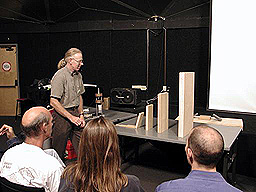


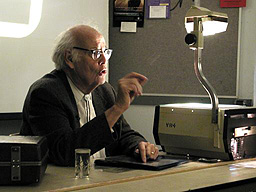


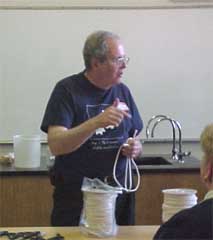
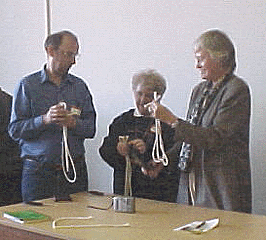

 Dave Wall
Dave Wall
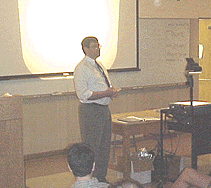 Our speaker, Wade Williams, addresses NCNAAPT.
Our speaker, Wade Williams, addresses NCNAAPT.